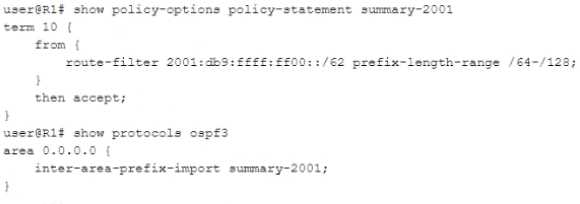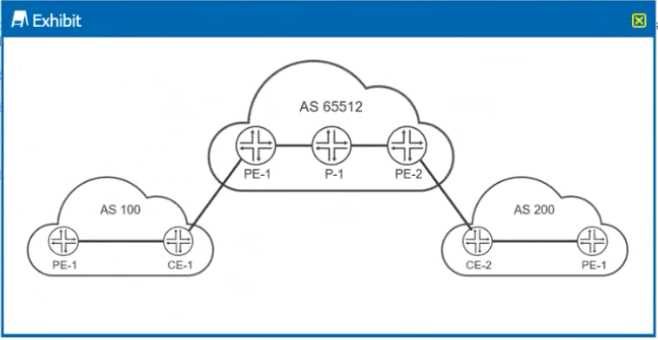Juniper jn0-663 practice test
Service Provider Routing and Switching, Professional (JNCIP-SP) Exam
Last exam update: Mar 26 ,2025
Question 1
You are establishing a Layer 3 VPN between two PE devices Currently you have a single internal IPv4
BGP peering between the PE devices. You must ensure that the IPv4 and IPv6 routes from both CE
devices are exchanged between these sites
Which two statements are correct in this scenario? (Choose two.)
- A. You must establish an IPv6 BGP peering between the two PEs
- B. You must enable the inet-vpn NLR on both PE devices.
- C. You must enable the inet6-vpn NLRI on both PE devices.
- D. You must enable IPv6 tunneling on the LSPs between the PE devices
Answer:
B, C
Question 2
Exhibit.
Referring to the exhibit, which command would reduce the size of the OSPF database and
corresponding routes?
A)
B)
C)
D)
- A. Option A
- B. Option B
- C. Option C
- D. Option D
Answer:
D
Question 3
Exhibit.
You are using EVPN to provide Layer 2 stretched VLANs between two sites You notice that the MAC
addresses in either site are not showing up on the remote site.
Referring to the exhibit, what are two ways to solve this problem? (Choose two )
- A. On R1, issue the sec 3wicch-cpt:.cr.3 vrf-target target: 65101:22030 Command
- B. On R2 issue the set protocols evpn vni-options vni 22030 command
- C. On R1, issue the sec protocols evpn vni-options vni 22030 vrf-target target:65101:22030 command
- D. On R2, issue the set switch-options vrf-target target: 65101:22030 command
Answer:
A, D
Question 4
Which two statements about wide and narrow metrics used in IS-IS are correct? (Choose two)
- A. Wide metrics are sent by default and use 24 bits in TLVs to send information
- B. Narrow metrics are enabled by default and use 8 bits in TLVs to send information
- C. Disabling narrow metrics results in external routes being leaked from L1 to L2 areas automatically
- D. Wide metrics are enabled with the wide-metrics-or.ly parameter under protocols IS-IS hierarchy.
Answer:
B, C
Question 5
Exhibit.
R2 is receiving a route from an EBGP neighbor and is advertising the route to R4
Referring to the exhibit, which configuration on R2 will solve the issue with the route on R4?
- A. Move the ahs policy from a global BGP export policy to an export policy under group 65002
- B. Move the no-advertise export policy from group 65001 to a global BGP policy.
- C. Move the no-export policy from a global BGP import policy to an import policy under group 65001.
- D. Move the no-advertise export policy from group 65002 to a global BGP policy.
Answer:
A
Question 6
Exhibit.
Two CE devices (CE-1 and CE-2) belong to the same customer and connect into a single PE device
(PE-1) However, the CE devices cannot communicate with each other You want to allow the CE
devices to communicate with each other
Referring to the exhibit, which action would solve the problem?
- A. Configure both routing instances with the set routing-opt ions auto-export-statement
- B. Configure both routing instances with the set routing-options autonomous-system loops 3 statement
- C. Configure both routing instances with the vrf-table-label statement
- D. Configure both routing instances with the as-override statement within the BGP protocol
Answer:
A
Question 7
Exhibit.
R2 has IS-IS adjacencies with R3 and R4 You want to ensure that R2 has both a level 1 and level 2
adjacency to both R3 and R4 but R2 only has one adjacency with R4.
Referring to the exhibit, which configuration change will solve this issue?
- A. Change the IS-IS area on R2 to match R4.
- B. Change the IS-IS area on R4 to match R2
- C. Remove the level 1 disable configuration from R4
- D. Remove the level 1 disable configuration from R2
Answer:
B
Question 8
Exhibit.
Referring to the exhibit, which statement is true?
- A. The BGP session between R1 and R2 will fail to establish correctly due to an NLRI mismatch
- B. The BGP session between R1 and R2 will establish correctly and the met unicast and the met6 unicast NLRIs will pass routing information
- C. The BGP session between R1 and R2 will establish correctly and only the inet6 unicast NLRI will pass routing information
- D. The BGP session between R1 and R2 will establish correctly and only the met unicast NLRI will pass routing information
Answer:
B
Question 9
What is the purpose of the duster-list attribute within a BGP route reflector group?
- A. to disable internal cluster re-advertisements
- B. to define the router that first advertised the route to the route reflector
- C. to override the router 10 value within the cluster
- D. to facilitate loop detection within the route reflector network
Answer:
D
Question 10
Exhibit.
Referring to the exhibit, which two statements are correct for a route advertised by R1 towards R4?
(Choose two )
- A. The BGP next hop is set to 192.168.2 2 by R2
- B. The BGP next hop is set to 14.1 1.1 byR2
- C. The AS path is set to null by R2
- D. The AS path is set to 150 by R2
Answer:
B
Question 11
Exhibit.
You are providing camer-of-carner VPN services for AS 100 and AS 200 You want to distribute MPLS
labels between your PE routers and the AS 100 and AS 200 CE routers.
What must be enabled to accomplish this task?
- A. Use BGP with the labeled-unicast address family enabled
- B. Use RSVP with the tunnel-services parameter enabled
- C. Use BGP with the inet-vpn address family enabled
- D. Use RSVP with the lsp-set parameter enabled
Answer:
C
Question 12
Exhibit.
Referring to the exhibit, there is an Layer 3 VPN setup that connects sites CE-A-1. CE-A-2 and CE-A-3
together Host-1 can communicate with Host-3. but Host-1 cannot communicate with Host-2
What must you do to solve the problem?
- A. Use the auto-export command in both routing instances
- B. Change the route distinguish^ in both routing instances to the same value
- C. Use the next-table configuration statement for static routes in the corresponding routing instances.
- D. Use BGP instead of static routing between the CE and PE devices
Answer:
A
Question 13
You have a mixed vendor EVPN environment and you need to ensure VXLAN interoperability
between all devices In this scenario which statement is correct?
- A. You should only use Type 6 and Type 2 routes
- B. You should only use pure Type 2 routes
- C. You should only use Type 2 and Type 5 routes.
- D. You should only use pure Type 5 routes
Answer:
C
Question 14
Exhibit.
Referring to the exhibit, which OSPFv3 configuration is implemented on router R1?
A)
B)
C)
D)
- A. Option A
- B. Option B
- C. Option C
- D. Option D
Answer:
B
Question 15
You are considering different MPLS VPN connectivity options of a new customer deployment Your
customer requires shared LSPs Layer 2 connectivity and auto-provisioning
Which type of VPN satisfies the requirements?
- A. BGP Layer 3 VPNs
- B. circuit cross-connects
- C. BGP Layer 2 VPNs
- D. LDP Layer 2 circuits
Answer:
C